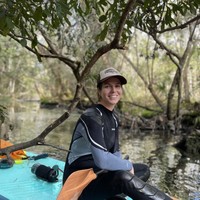
Corey Malcom
Phone: (305) 304-1136
Address: Florida Keys History Center
700 Fleming St.
Key West, FL 33040
Address: Florida Keys History Center
700 Fleming St.
Key West, FL 33040
less
Related Authors
Melissa R . Price
Florida Bureau of Archaeological Research
Maksim Mikhaylov
Mordovian State University
Allen D Wilson
United States Army
InterestsView All (20)









Uploads
Videos by Corey Malcom
The shipwreck was initially called the “St. Johns Bahamas Wreck,” because it was discovered by St. Johns Expeditions, a Florida-based shipwreck salvage company. In a unique arrangement, St. Johns turned their discovery to the Mel Fisher Maritime Museum for a wholly archaeological study; the artifact collection to remain intact in both Key West and The Bahamas.
Papers by Corey Malcom
(Note: This publication utilizes 3D-PDF technology. After download, it is best viewed on an electronic PDF reader. To enable 3D-PDF content, in your PDF reader, go to Edit > Preferences > check "Enable playing of 3D content".)
By comparing the archaeological evidence to the historical record, it becomes clear that the St. Johns shipwreck is the Santa Clara, a 300-ton Carrera de Indias galleon owned by the famed Spanish mariner Pedro Menéndez de Avilés. While returning to Spain in October of 1564, the ship grounded on a reef in the western Bahamas and could not be freed. Its cargo of silver and the people on board were safely removed to an accompanying vessel, and the Santa Clara was abandoned. With the identity and specific circumstances of the shipwreck known, it serves as an important touchstone in the understanding of the early Spanish colonial system.
The shipwreck was initially called the “St. Johns Bahamas Wreck,” because it was discovered by St. Johns Expeditions, a Florida-based shipwreck salvage company. In a unique arrangement, St. Johns turned their discovery to the Mel Fisher Maritime Museum for a wholly archaeological study; the artifact collection to remain intact in both Key West and The Bahamas.
(Note: This publication utilizes 3D-PDF technology. After download, it is best viewed on an electronic PDF reader. To enable 3D-PDF content, in your PDF reader, go to Edit > Preferences > check "Enable playing of 3D content".)
By comparing the archaeological evidence to the historical record, it becomes clear that the St. Johns shipwreck is the Santa Clara, a 300-ton Carrera de Indias galleon owned by the famed Spanish mariner Pedro Menéndez de Avilés. While returning to Spain in October of 1564, the ship grounded on a reef in the western Bahamas and could not be freed. Its cargo of silver and the people on board were safely removed to an accompanying vessel, and the Santa Clara was abandoned. With the identity and specific circumstances of the shipwreck known, it serves as an important touchstone in the understanding of the early Spanish colonial system.